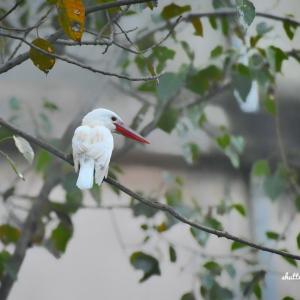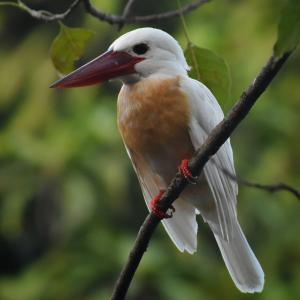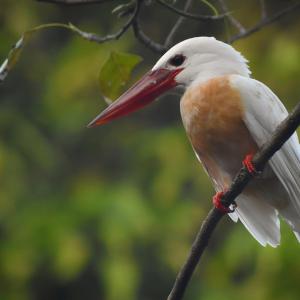A LEUCISTIC STORK-BILLED KINGFISHER (Pelargopsiscapensis) IN KOLKATA, WEST BENGAL.
A LEUCISTIC STORK-BILLED KINGFISHER (Pelargopsiscapensis) IN KOLKATA, WEST BENGAL.
We all know the importance of birds, in Indian subcontinent there are a total of 1,313 species (with an additional 87 species proposed for splitting) had been confirmed from the Indian subcontinent. As many as 13% of the world's birds have been recorded in the region. These includes 157 endemic species, a more than 10% of the region avifuana. The bird habitats of the Indian subcontinent can be roughly divided into forests, scrubs, wetlands(inland and littoral), marine, grassland, desert, and agricultural land. There are some overlap between habitats, for example - mangrove forest can also be considered as wetland, as can sessional flooded grassland. Many bird species require mixed habitat types.
Mainly I'm attracted to kingfishers (Alcedinidae) small to medium sized birds, with large heads, long strong bills, and short legs. Most kingfishers spend long periods perched single or in well-separated pairs, watching intently before plunging swiftly downwards to seized prey with bill. They eat mainly fish, tadpoles, and invertebrates larger species also eat frogs, snakes, crabs, lizards etc, there flight is direct and strong with rapid wingbeats and often close to the surface. Kingfishers are generally shy birds, but inspite of this, they feature heavily in human culture. Individual species may have massive ranges, like the common kingfishers which ranges across Africa and Asia. In South Bengal 8 kinds of kingfishers are available, they are common kingfishers (alcedoatthis), white-throated kingfishers (halcyon smyrnensis), stork-billed kingfishers (pelargopsiscapensis), black-capped kingfishers (halcyon pileata), collard kingfishers (todiramphuschloris), brown-winged kingfishers (pelargopsisamauroptera), pied kingfishers (cerylerudis), ruddy kingfishers (halcyon coromanda). Other species have much smaller ranges, particularly insular species which are endemic to single islands kingfishers occupy a wide range of habitats. While they are often associated with rivers and lakes. Over half the world species are found in forests and forested streams. They also occupy a wide range of other habitats, numerous species have adapted to human-modified habitats, particularly those adapted to woodlands and may be found in cultivated and agricultural areas as well as parks and gardens in towns and cities.
While birding in the winter season on 18th December 2018, I went out to shoot few winter migrated birds in my local areas. There are few ponds in front of my house and I use to wake up early five in the morning for birding. On 18th December 2018 while I am taking photos of a coppersmith barbet, suddenly a white bird past me. At first I didn't recognized it whether it’s a common bird or something else, but suddenly I saw it sitting it on a branch of tree and it’s a colour-aberrant kingfisher near my house at Sodepur, Kolkata, West Bengal. Initially I was confused by it, but when I got closer view, I thought it was a stork-billed kingfisher (Pelargopsiscapensis) on it size and the colour of its upper and lower mandibles rather than the similar Black caped kingfisher (Halcyon pileata). On 19th December 2018 again I saw it at mid-day, but the bird kept far from me and did not allowed closeup photographs. It was calling, and its call matched that of a stork billed kingfisher, an explosive, shrinking ke-ke-ke-ke-ke and a pleasant peer,peer,pur. I was unable to photograph it next day also, it seems difficult for me to cover with my 70-300 mm lens but I tried my level best to keep a record shot of that wonderful bird. The fifth day I was able to photograph it, looked exactly like a stork-billed kingfisher except for its white plumage, I watched the bird almost one-and-a-half hours. I observed that though the feathers of the individual were all white except the breast side its eyes and feet are normal in colouration, unlike an Albino, which would have red eyes, pink feet. As the colour of both the mandibles, the feet and the eyes was not affected by the pigmentation loss and remained always true to that of a normal Stork-billed kingfisher, I took help from my seniors and considered this individual to be a leucistic bird as described in Grouw (2006) and Mahabal et all (2016). I would like to thank all my seniors for guiding me with all identification help.
REFERENCES
Grimmett,R,Inskipp,C, and Inskipp,T,2011. Birds of Indian subcontinent. 2nd Ed. London: Oxford university press.
Grouw,H,V.,2006. Not every white bird is albino: sense and nonsense about colour aberration in birds.






